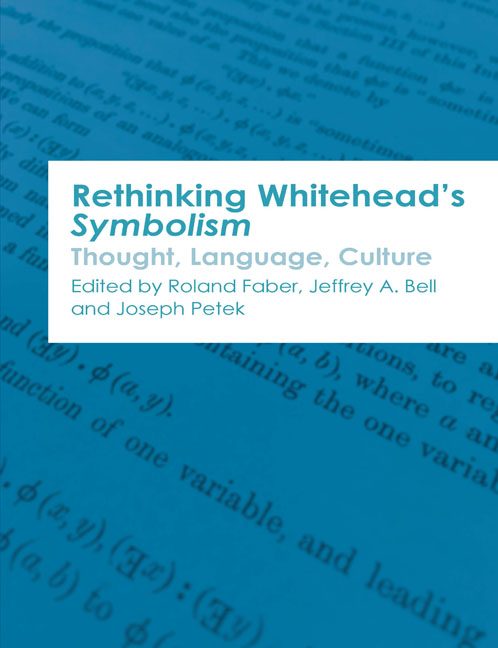Book contents
- Frontmatter
- Contents
- Abbreviations
- Introduction
- Part I Perception and Paradox
- Part II Adventures in Culture and Value
- 4 The Inhumanity of Symbolism
- 5 Reverence, Revision and Creaturely Life: Whitehead's Political Theology of Enjoyment
- 6 Ren and Causal Efficacy: Confucians and Whitehead on the Social Role of Symbolism
- 7 Avoiding a Fatal Error: Extending Whitehead's Symbolism Beyond Language
- Part III Misplaced Concreteness in Ethics and Science
- Notes on Contributors
- Index
5 - Reverence, Revision and Creaturely Life: Whitehead's Political Theology of Enjoyment
from Part II - Adventures in Culture and Value
Published online by Cambridge University Press: 23 June 2018
- Frontmatter
- Contents
- Abbreviations
- Introduction
- Part I Perception and Paradox
- Part II Adventures in Culture and Value
- 4 The Inhumanity of Symbolism
- 5 Reverence, Revision and Creaturely Life: Whitehead's Political Theology of Enjoyment
- 6 Ren and Causal Efficacy: Confucians and Whitehead on the Social Role of Symbolism
- 7 Avoiding a Fatal Error: Extending Whitehead's Symbolism Beyond Language
- Part III Misplaced Concreteness in Ethics and Science
- Notes on Contributors
- Index
Summary
The figure of the creature, in the work of Alfred North Whitehead, functions as an almost superficial or superfluous category. The creature serves, primarily, as a cognate term for the actual entity or the ‘individual fact’ (PR 20): the concretion left in the wake of creativity. It is as if the figure of the creature is merely a shadow, a reminder that actual entities are conditioned by creativity itself. God, like other actual entities, is a creature rather than a creator – God is transcended by creativity (PR 88). And yet God still carries other ontological functions in Whitehead's philosophy. The figure of the creature, on the other hand, carries no ontological function that is all its own. It seems to float, like decorative adornment, throughout Whitehead's corpus.
The questions I pursue here, then, are quite rudimentary. What might the function of the creature have been, for Whitehead, in the first place? Does the creature play a conceptual role, beyond a shadow concept for creativity? Does it function as anything more than adornment? I argue that the creature is important in Whitehead's philosophy, perhaps above all as symbol. It is when we examine the creature as symbol (rather than, say, as ontological category) that its more integral features begin to emerge. Moreover, when the symbolic contours of creatureliness become visible in Whitehead's thought, what also becomes visible is the figure of a creature who symbolises resistance to a despotic deity. We see, instead, not a creature who cuts ties with the divine, but one who sources divinity for enjoyment. To the extent that Whitehead's own conceptual resistance against this form of divinity is informed by (and responsive to) Western intellectual history and politics, I have been tempted to call this a political theology.
Symbolism itself, like the figure of the creature in his work, ‘has an unessential element in its constitution’, Whitehead argued (S 1). It is almost arbitrarily discarded and adopted. And yet Whitehead also argued that when we reduce the process of symbolisation down to its bare bones, what we are left with are trains of reference (S 7). Symbolism, perhaps, is where we find the genetic strains and traces of cultural value. Symbolism itself is arbitrary. But symbols are culturally chosen and reinvented.
- Type
- Chapter
- Information
- Rethinking Whitehead’s SymbolismThought, Language, Culture, pp. 96 - 107Publisher: Edinburgh University PressPrint publication year: 2017



